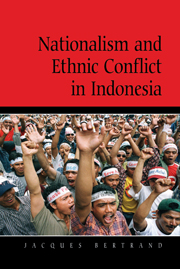Book contents
- Frontmatter
- Contents
- List of figures and tables
- Preface
- Maps
- 1 Introduction
- 2 Critical junctures, nationalism, and ethnic violence
- 3 The national model and its institutional history
- 4 Exclusion, marginality, and the nation
- 5 Islam and nation: The Muslim–Christian dimension
- 6 The escalation of religious conflict
- 7 Conflict in Maluku
- 8 Late integration into the nation: East Timor and Irian Jaya (Papua)
- 9 Aceh's ethnonationalist conflict
- 10 Autonomy as a solution to ethnic conflict
- 11 Unity in diversity
- Notes
- Glossary
- Bibliography
- Index
- CAMBRIDGE ASIA–PACIFIC STUDIES
8 - Late integration into the nation: East Timor and Irian Jaya (Papua)
Published online by Cambridge University Press: 10 December 2009
- Frontmatter
- Contents
- List of figures and tables
- Preface
- Maps
- 1 Introduction
- 2 Critical junctures, nationalism, and ethnic violence
- 3 The national model and its institutional history
- 4 Exclusion, marginality, and the nation
- 5 Islam and nation: The Muslim–Christian dimension
- 6 The escalation of religious conflict
- 7 Conflict in Maluku
- 8 Late integration into the nation: East Timor and Irian Jaya (Papua)
- 9 Aceh's ethnonationalist conflict
- 10 Autonomy as a solution to ethnic conflict
- 11 Unity in diversity
- Notes
- Glossary
- Bibliography
- Index
- CAMBRIDGE ASIA–PACIFIC STUDIES
Summary
Ethnonationalism has been a significant manifestation of ethnic conflict in New Order Indonesia. In conflicts in East Timor, Irian Jaya, and Aceh, groups identified as “East Timorese,” “Papuan,” and “Acehnese” conceived of themselves as distinct nations on the basis of ethnic differences. The process by which these groups were integrated into the Indonesian state, and subsequent policies designed to maintain those boundaries, contributed to their alienation from an otherwise inclusive Indonesian nation.
The development of ethnonationalist resistance in East Timor and Irian Jaya differs in some respects from that in Aceh. East Timor and Irian Jaya were integrated into Indonesia well after the revolution of 1945, and no significant Indonesian nationalist sentiment developed among East Timorese and Papuans prior to that time. The Acehnese joined the Indonesian nationalist movement and fought with other ethnic groups against the Dutch. Whereas groups of East Timorese and Papuans resisted from the moment of their integration, in Aceh such resistance emerged much later. Consequently, for many East Timorese and Papuans, ethnonationalism reflected a rejection of the fact and process of integration into the Republic, whereas in Aceh it represented a reaction to the treatment of Acehnese under the Indonesian state.
The process of late integration marks a traumatic critical juncture in the histories of East Timor and Irian Jaya. It defined the terms of inclusion and fixed in the imaginations of the East Timorese and Papuans a meaning to inclusion within the Indonesian nation that was different from other groups in the archipelago.
- Type
- Chapter
- Information
- Nationalism and Ethnic Conflict in Indonesia , pp. 135 - 160Publisher: Cambridge University PressPrint publication year: 2003



